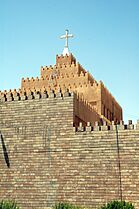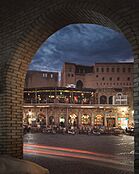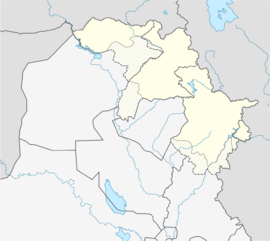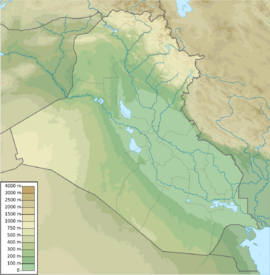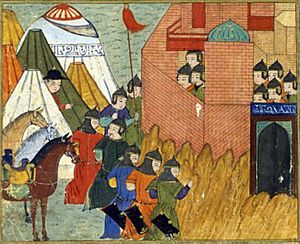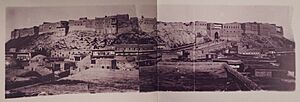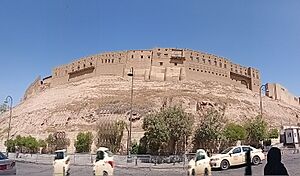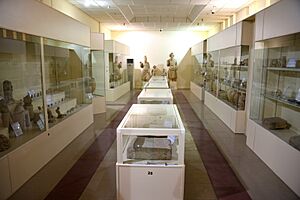Erbil facts for kids
Quick facts for kids
Erbil
ھەولێر
Hewlêr
|
|
|---|---|
|
Top-bottom, R-L:
Downtown Erbil Mudhafaria Minaret • Nature in Erbil Textile Museum • Citadel of Erbil Cathedral of Saint Joseph • Street view from Erbil Citadel |
|
| Nickname(s):
The City of Citadel and Minaret
(Kurdish: شاری قەڵا و منارە) |
|
| Country | |
| Autonomous region | |
| Governorate | Erbil |
| Area | |
| • Total | 115 km2 (44 sq mi) |
| • Land | 113 km2 (44 sq mi) |
| • Water | 2 km2 (0.8 sq mi) |
| Elevation | 390 m (1,280 ft) |
| Population | |
| • Estimate
(2018)
|
879,071 |
| • Density | 10,435/km2 (27,030/sq mi) |
| Time zone | UTC+3 (AST) |
| Postal code |
44001
|
| Area code(s) | 066 |
| Website | HawlerGov.org |
Erbil (Arabic: أربيل, Arbīl), also called Hawler (Kurdish: هەولێر, Hewlêr), is a very old and important city. It is the capital and largest city in the Kurdistan Region of Iraq. The city is located in the Erbil Governorate.
People have lived in Erbil for a very long time, possibly since 5000 BC! At the heart of the city, you'll find the ancient Citadel of Erbil and the Mudhafaria Minaret. The first historical records mentioning this area date back to the Third Dynasty of Ur in Sumer, when a king named Shulgi talked about a city called Urbilum. Later, the city was taken over by the Assyrians.
Over many centuries, Erbil was ruled by different powerful empires. These included the Median Empire, the Achaemenid Empire, the Macedonian Empire of Alexander the Great, and later the Parthian Empire and Sasanian Empire. It was also the capital of a smaller state called Adiabene for a while.
After the Muslim conquest of Persia, Erbil became part of different empires during the Middle Ages, like the Seljuks and the Ottoman Empire.
Today, Erbil has an amazing archaeological museum filled with ancient artifacts from before Islam. It's a key place for archaeological digs in the area. In 2014, the city was named the Arab Tourism Capital. Also, in July 2014, the Citadel of Erbil was recognized as a World Heritage Site, which means it's a very special place for everyone to protect.
Contents
What's in a Name?
The name Erbil comes from its Ottoman Turkish name. In Modern Standard Arabic, it's called Arbīl. Long ago, in ancient Greek and Latin, it was known as Arbela. This name came from even older languages like Old Persian and Assyrian, which got it from the Sumerian name Urbilum.
Exploring the Past: Archaeology
Archaeologists have been studying Erbil to learn more about its long history. In 2006, a small dig found pottery pieces from different time periods, from the Stone Age to the Iron Age. Because people have lived on the site for so long, it's hard to dig deep without disturbing newer layers.
In 2013, a team used special radar to look underground in the citadel. Since 2014, Iraqi teams have been digging where a modern building collapsed, giving them a chance to explore.
The flat land around Erbil also has many interesting ancient sites. The Erbil Plain Archaeological Survey started in 2012. They use satellite images and fieldwork to find and study old settlements. One huge site, Tell Baqrta, is about 80 hectares (like 150 football fields!) and dates back to the Early Bronze Age.
Erbil Through Time: A Brief History
Ancient Times

Bronze Age (around 3000 BC to 1000 BC)
The area where Erbil is located was mostly controlled by the Sumerians around 3000 BC. Later, the Akkadian Empire united all of Mesopotamia. Around 2150 BC, a king named Erridupizir from the kingdom of Gutium captured Erbil.
The city of Erbil (called Irbilum then) was first mentioned in ancient writings from the kingdom of Ebla around 2300 BC. Later, a Sumerian ruler named Amar-Sin attacked Urbilum around 1975 BC.
After the Sumerian empire fell, Erbil became a powerful city in its region. It was conquered by Shamsi-Adad I for a short time but became independent again. By the time of the Middle Assyrian Empire (1365–1050 BC), Erbil was under Assyrian control.
Iron Age (around 1000 BC to 500 AD)
During the Neo-Assyrian Empire (935–605 BC), Erbil was part of this powerful kingdom. After that, the city changed hands many times, being ruled by the Persians, Greeks, Parthians, Romans, and Sassanids.
One of the most famous battles in history, the Battle of Gaugamela, happened near Erbil in 331 BC. In this battle, Alexander the Great defeated Darius III of Persia. Darius fled to Erbil after the battle.
Erbil later became the capital of a state called Adiabene. This kingdom is known in Jewish history because its royal family, including Queen Helena of Adiabene, converted to Judaism. Early Christianity also grew in Erbil, with its first bishop, Pkidha, around 104 AD.
Medieval History (around 500 AD to 1500 AD)
After the Muslim conquest of Persia, the region saw more Muslim people, like Arabs and Turkic peoples, move in. Erbil was then ruled by different groups, including the Seljuks and the Ottomans.
A notable Kurdish tribe, the Hadhabani, governed the city for a while. Later, the Zengids took over, and a Turkic governor named Gökböri ruled Erbil during the Ayyubid era. Writers from the 13th century described Erbil as being mostly populated by Kurds.
When the Mongols invaded the Middle East in the 13th century, they attacked Erbil in 1237. They looted the lower town but couldn't capture the citadel right away. After the fall of Baghdad in 1258, the Mongols returned and captured the citadel after a six-month siege. They appointed a Christian Assyrian governor, and the Syriac Orthodox Church was allowed to build a church.
However, later Mongol rulers started to persecute Christians. In 1310, the Assyrian inhabitants of Erbil retreated to the citadel for safety. After a siege by Mongol troops and Kurdish tribesmen, the citadel was captured, and many defenders were killed.
The city's Assyrian population remained important until the city was destroyed by the forces of Timur in 1397.
Over the Middle Ages, Erbil was ruled by many different groups, including the Umayyads, Abbasids, Buwayhids, Seljuks, and others. Famous Kurdish historians and writers, Ibn Khallikan and Ibn al-Mustawfi, were born in Erbil in the 12th and 13th centuries.
After the Battle of Chaldiran in 1514, Erbil came under the Soran Emirate. Later, the Baban Emirate took the city, but it was recaptured by the Soran ruler Mir Muhammed Kor in 1822. The Soran emirate ruled Erbil until the Ottomans took it in 1851. Erbil was part of the Ottoman Empire until World War I, when the Ottomans were defeated by the British Empire.
Modern History (1900s to Today)
Erbil is located on a flat plain below mountains. The modern city is built around an ancient mound, or tell, topped by an Ottoman fort. In the Middle Ages, Erbil was a major trading hub between Baghdad and Mosul, and it still plays an important role in trade today.
Erbil is also home to many refugees who have come seeking safety from conflicts in nearby countries like Syria. In 2020, it was estimated that 450,000 refugees had settled in the Erbil area since 2003.
The parliament of the Iraqi Kurdistan was set up in Erbil in 1970. This happened after talks between the Iraqi government and the Kurdistan Democratic Party (KDP). However, Saddam Hussein controlled it until the Kurdish uprising after the 1991 Gulf War. The parliament stopped working well in the mid-1990s due to fighting between the KDP and the Patriotic Union of Kurdistan (PUK). The KDP captured the city in 1996 with help from Saddam Hussein's government. The PUK then formed a different Kurdish government in Sulaimaniyah.
The Kurdish Parliament in Erbil started meeting again after a peace agreement in 1997, but it didn't have much power. The Kurdish government in Erbil only controlled the western and northern parts of the region. During the 2003 invasion of Iraq, a United States special forces team was based near Erbil. The city celebrated on April 10, 2003, when Saddam Hussein's government fell.
During the U.S. occupation of Iraq, Erbil experienced occasional attacks. The Erbil International Airport opened in 2005, making travel easier. In 2015, the Assyrian Church of the East moved its main office to Erbil.
Getting Around: Transportation
Erbil International Airport is one of Iraq's busiest airports. You can fly directly to other cities in Iraq, like Baghdad. There are also international flights from Erbil to many countries, including the Netherlands, Germany, Saudi Arabia, Turkey, and Jordan. The airport was briefly closed to international flights in 2017 but reopened in 2018.
Buses are another important way to travel to and from Erbil. Bus services connect the city to places like Turkey and Iran. A new bus terminal opened in 2014. Erbil also has a system of six ring roads that go around the city.
Weather in Erbil: Climate
Erbil has a hot-summer Mediterranean climate. This means it has long, very hot summers and mild winters. Summers are dry, with almost no rain from June to September. Winters are usually wet, and sometimes there are floods. January is the wettest month.
In December 2021, heavy rain caused flash floods in the area, which sadly resulted in 14 deaths.
People and Culture
Who Lives in Erbil? Demographics
The city is mostly populated by Kurds. There are also smaller groups of local Turkmen and Assyrians, as well as Arabs.
Turkmen Community
It's estimated that about 300,000 Turkmen people live in Erbil. They mainly live in neighborhoods like Taci, Mareke, and Three Tak in the city center. Until 2006, many lived in the Tophane, Tekke, and Saray areas of the Citadel. In 2006, the Citadel was emptied for restoration, and the Turkmen living there moved to other neighborhoods. Turkmen people are involved in the government of the Kurdistan Region.
Iraq's first two Turkmen schools opened in 1993, one in Erbil and one in Kifri. The Citadel of Erbil also has a Turkmen Culture House.
Assyrian Community
Erbil's Ankawa district is mostly home to Christian Assyrians. This district has about 40 churches.
The Amazing Citadel of Erbil
The Citadel of Erbil is a large mound in the historical center of Erbil. It rises about 25 to 32 meters (82 to 105 feet) from the flat land around it. The buildings on top cover an oval area of about 430 by 340 meters (1,410 by 1,115 feet). Some people say it's the oldest continuously inhabited town in the world! The earliest signs of people living on the citadel mound go back to the fifth millennium BC, or even earlier.
It became very important during the Neo-Assyrian Empire (10th to 7th centuries BC). During the Sassanian period and the Abbasid Caliphate, Erbil was a key center for Syriac Christianity and the Assyrians. After the Mongols captured the citadel in 1258, Erbil's importance started to decrease.
In the 20th century, many old houses and buildings were destroyed as the city grew. In 2007, a special group was created to oversee the restoration of the citadel. Most people were moved out so that a big restoration project could begin. Since then, archaeologists and restoration teams have been working there. Many areas are still closed to visitors because some walls are not stable. The government plans for 50 families to live in the citadel once it's fully renovated.
The only religious building still standing in the citadel is the Mulla Effendi mosque. When it was fully lived in, the citadel had three main areas: Serai, Takya, and Topkhana. The Serai was for important families, Takya was named after dervish homes, and Topkhana was for craftsmen and farmers. Other interesting places to visit in the citadel include old bathing rooms (hammam) built in 1775 and the Textile Museum. The Erbil Citadel was added to the World Heritage List on June 21, 2014.
Other Cool Places to See
- The Mudhafaria Minaret is 36 meters (118 feet) tall and is in Minaret Park, a few blocks from the citadel. It dates back to the late 12th century. It has an octagonal base with two levels of decorated niches.
- Sami Abdul Rahman Park is a large, beautiful park.
- The Mound of Qalich Agha is inside the Museum of Civilization grounds, about 1 kilometer (0.6 miles) from the citadel. Digs in 1996 found tools from very old periods.
- Classical School of the Medes
Sports in Erbil
The main local football (soccer) team is Erbil Soccer Club. They play their matches at Franso Hariri Stadium, named after a famous Assyrian politician. The team has won 3 Iraqi national league titles and reached the AFC Final twice.
Sister Cities
Erbil has a sister city relationship with:
 Nashville, Tennessee, United States of America
Nashville, Tennessee, United States of America
See also
 In Spanish: Erbil (Irak) para niños
In Spanish: Erbil (Irak) para niños







